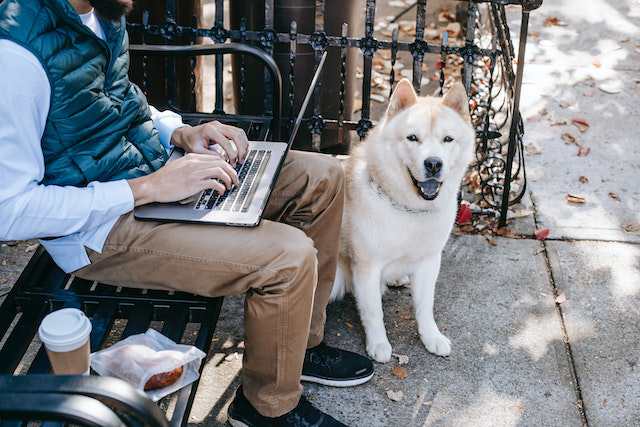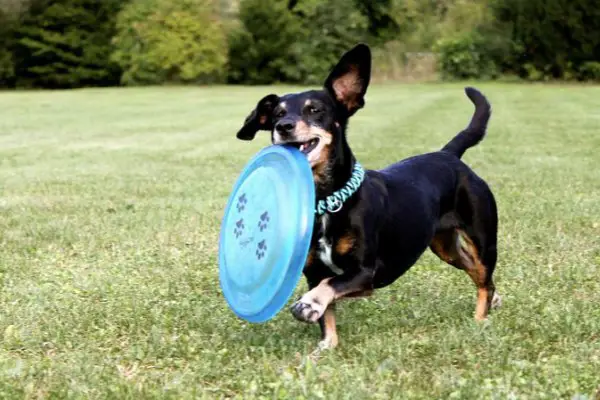Territorial Behavior in Dogs [Signs, Causes, & Solutions]
![Territorial Behavior in Dogs [Signs, Causes, & Solutions] Territorial Behavior in Dogs](https://petcreeks.com/wp-content/uploads/2023/10/pexels-lucas-pezeta-2034913.jpg)
Today, let’s dive into the fascinating world of territorial behavior in dogs.
Have you ever wondered why your dog goes all protective over his favorite spot or barks at every passing squirrel?
Well, buckle up and get ready to unleash some insights on what makes our furry friends tick when it comes to defending their turf.
What is territorial behavior in dogs?
Territorial behavior in dogs refers to their instinct to protect and defend a specific area, such as their home or yard, from perceived intruders or threats.
This behavior is a natural part of a dog’s instincts and can vary in intensity depending on the breed and individual personality.
Signs of Territorial Behavior in Dogs
![Territorial Behavior in Dogs [Signs, Causes, & Solutions] Signs of Territorial Behavior in Dogs](https://petcreeks.com/wp-content/uploads/2023/12/miranda-garside-OXSTyQ864k-unsplash.jpg)
Signs of territorial behavior in dogs can include barking or growling at strangers approaching the home, marking or scenting specific areas within the house or yard, and exhibiting defensive body languages such as raised hackles and a stiff posture.
Let’s break it down further…
Here are some of the most common signs of territorial behavior in dogs:
1. Barking and Growling: Dogs have a natural instinct to vocalize their territorial claims. When they perceive a threat to their territory, they may bark or growl to communicate their presence and warn potential intruders. The intensity of the barking or growling can vary depending on the dog’s personality and the perceived level of threat.
2. Urine Marking: Dogs use urine marking as a way to define and defend their territory. By urinating on vertical surfaces like trees, bushes, or even furniture, they leave their scent behind, signaling to other animals that the area is claimed. Male dogs often lift their leg to mark higher surfaces, while females may squat to mark lower objects.
3. Fence Running: Dogs with territorial tendencies may become highly reactive when they see other animals or people near their territory boundaries, such as a fence or property line. They may run back and forth along the fence, barking, and displaying signs of agitation. This behavior is an attempt to defend their territory and keep intruders at bay.
4. Guarding Possessions: Dogs may exhibit possessive or territorial behavior when it comes to their belongings. This can include toys, food bowls, bedding, or any item they consider valuable. They may growl, snap, or even bite if someone tries to approach or take away these possessions. It’s important to address this behavior through training and teaching the dog appropriate boundaries.
5. Body Language: Dogs often use body language to communicate their territorial intentions. When feeling territorial, they may raise the fur along their back (known as hackles), assume a stiff posture, have a rigid tail, or display intense staring. These physical signals are meant to convey a sense of dominance and assertiveness.
6. Lunging or Charging: In response to a perceived threat, territorial dogs may lunge or charge towards the intruder. This behavior is an attempt to intimidate and drive away the perceived trespasser. It’s important to note that lunging or charging can be dangerous, especially if the dog’s behavior escalates into aggression. Proper training and management are crucial to address this type of behavior.
7. Overly Protective Behavior: Dogs with strong territorial instincts may exhibit overprotective behavior towards their human family members. They may become anxious or show signs of aggression when strangers or unfamiliar people approach their owners. This behavior stems from a desire to guard and protect their pack. It’s important to socialize dogs properly and teach them appropriate behavior around strangers to prevent any potential issues.
8. Body Blocking: Dogs might physically position themselves between the perceived threat and their territory, using their body to block further intrusion. This behavior is an attempt to protect their space and establish control over the situation.
9. Stiff or Intense Stare: A dog’s gaze can be quite telling. When they fixate on a person or another animal entering their territory, it’s a sign of vigilance and a warning to stay away.
Remember, while some degree of territorial behavior is normal, it’s essential to distinguish between healthy territorial behavior and behavior that becomes excessive, aggressive, or poses a risk to others.
Causes of Territorial Behavior in Dogs
![Territorial Behavior in Dogs [Signs, Causes, & Solutions] Causes of Territorial Behavior in Dogs](https://petcreeks.com/wp-content/uploads/2023/12/janko-ferlic-ZMwKdVWMrQk-unsplash.jpg)
Territorial behavior in dogs is often linked to their instincts to protect their resources, such as food, shelter, and companions.
It can also be influenced by past experiences and the dog’s environment, including how they were socialized and trained.
Let’s break it down further…
Here are some of the most common causes of territorial behavior in dogs:
1. Instinctual Behavior: Dogs have inherited a natural instinct to protect their territory, which is deeply rooted in their ancestry as pack animals and hunters. This instinctual behavior is an evolutionary trait that has helped dogs survive and thrive in the wild.
When a dog perceives a threat to its territory or resources, such as food or shelter, it may exhibit territorial behavior as a means of defending what it considers its own.
2. Lack of Socialization: Socialization is crucial for dogs to develop the ability to interact positively with other animals and people. Dogs that have not been properly socialized during their critical developmental period may become anxious or defensive in unfamiliar situations.
This lack of exposure to different environments and stimuli can contribute to territorial behavior, as the dog may perceive anything unfamiliar as a potential threat.
3. Fear and Anxiety: Fear and anxiety are powerful drivers of territorial behavior in dogs. When a dog feels threatened or insecure, it may react defensively to protect itself and its territory.
This can manifest as aggressive behavior towards perceived intruders, whether they are other animals or unfamiliar humans. Understanding and addressing the underlying causes of fear and anxiety is essential for managing territorial behavior in dogs.
Learn more about dealing with dog anxiety.
4. Resource Guarding: Resource guarding is a common trigger for territorial behavior in dogs. This behavior occurs when a dog perceives a threat to its possessions, such as food, toys, or resting areas. Resource guarding can range from subtle behaviors like stiffening or growling to more overt displays of aggression.
Addressing resource guarding requires a combination of training, management, and behavior modification to help the dog feel secure and comfortable without the need to guard its resources.
5. Lack of Training and Boundaries: Dogs thrive on structure and clear boundaries. Without proper training and consistent reinforcement of boundaries, dogs may struggle to understand what is expected of them in various situations.
This lack of guidance can contribute to territorial behavior as the dog attempts to assert control over its environment in the absence of clear direction from its owners.
Consequences of Territorial Behavior in Dogs
So, territorial behavior in dogs can lead to a range of consequences, such as aggression towards other animals or people encroaching on their perceived territory.
This behavior can also result in excessive barking, dog attacks, markings, or even destructive tendencies within the home.
Additionally, it may make it challenging to introduce new pets or visitors to the dog’s environment.
Understanding and addressing this behavior through training and positive reinforcement can help mitigate these consequences and create a safer, more harmonious living environment for both the dog and its human companions.
Addressing and Managing Territorial Behavior in Dogs
![Territorial Behavior in Dogs [Signs, Causes, & Solutions] Addressing and Managing Territorial Behavior in Dogs](https://petcreeks.com/wp-content/uploads/2023/12/for-chen-0jhte3YdBLI-unsplash.jpg)
Here are some of the most common ways of addressing and managing territorial behavior in dogs:
1. Socialization: Socializing your dog is crucial for their overall development and helps them become more comfortable in different situations. Introduce your dog to various people, animals, and environments from a young age.
Encourage positive interactions and reward calm behavior during these encounters. Gradually expose them to different stimuli, such as loud noises or crowded areas, to help desensitize them and reduce territorial reactions.
2. Positive reinforcement training: Use positive reinforcement techniques to reward your dog for desired behavior. When they exhibit calm and non-aggressive behavior in situations that would typically trigger territorial behavior, praise and reward them with treats, toys, or verbal praise.
Positive reinforcement helps your dog associate good behavior with positive experiences, making them more likely to repeat those behaviors.
3. Desensitization and counter-conditioning: Desensitization involves gradually exposing your dog to the triggers that cause territorial behavior. For example, if your dog becomes reactive when someone approaches your home, start by having a friend walk by at a distance and reward your dog for remaining calm. Gradually decrease the distance over time while continuing to reward calm behavior.
Counter-conditioning involves pairing the trigger with something positive, such as treats or playtime. This helps your dog develop positive associations with previously anxiety-inducing situations.
4. Provide a safe space: Dogs need a designated safe space where they can retreat and feel secure, especially when they feel anxious or stressed. Create a comfortable area with a bed, toys, and familiar scents.
This can be a crate or a specific room in your home. Encourage your dog to use this space by making it a positive and peaceful environment. Ensure that family members and guests respect your dog’s safe space and avoid disturbing them when they are in it.
5. Avoid reinforcing territorial behavior: It’s essential not to inadvertently reinforce your dog’s territorial behavior. For example, if your dog barks at someone approaching your property, avoid praising or comforting them in response to the barking.
Instead, redirect their attention to more appropriate behavior, such as sitting or lying down, and reward them for calm behavior. By doing so, you are teaching your dog that calm behavior is more rewarding than reacting territorially.
6. Controlled introductions: When introducing your dog to new people or animals, do so in a controlled environment. Start with the neutral territory, such as a park or a friend’s backyard. Gradually increase exposure and monitor your dog’s behavior closely.
Reward and praise your dog for remaining calm and non-aggressive. If your dog shows signs of territorial behavior, such as growling or barking, remove them from the situation and try again later. Slowly acclimate your dog to new individuals or pets to help them develop positive associations.
7. Consistency and routine: Dogs thrive on consistency and routine, as it provides them with a sense of security and stability. Establish a predictable routine for feeding, exercise, and training.
This helps reduce stress and anxiety, which can contribute to territorial behavior. Ensure that all family members follow the same rules and guidelines to maintain consistency in your dog’s environment.
8. Seek professional help if needed: If your dog’s territorial behavior persists or escalates despite your efforts, it may be beneficial to consult a professional dog trainer or behaviorist.
They can assess the situation, provide specialized guidance, and develop a tailored behavior modification plan for your dog. Professional help can be particularly valuable when dealing with severe or aggressive territorial behavior.
Related Questions
Can territorial behavior be managed or modified?
Yes, with proper training and socialization, territorial behavior in dogs can be managed or modified. Positive reinforcement and desensitization techniques can help dogs learn to be more relaxed and less reactive in territorial situations.
Are some dog breeds more prone to territorial behavior?
Yes, certain breeds, such as guard dogs and those bred for protection, may exhibit more pronounced territorial behavior. However, individual temperament and training also play a significant role in a dog’s behavior.
How can I address territorial behavior in my dog?
Consistent training, socialization, and providing positive experiences with visitors can help address territorial behavior in dogs. It’s important to work with a professional trainer or behaviorist to develop a tailored plan for your dog’s specific needs.
Conclusion
So there you have it, folks! Dogs are amazing creatures with their own unique personalities and instincts. Understanding and managing territorial behavior is key to fostering a harmonious environment for both your furry friend and your household. Remember, with love, patience, and proper training, you can help your pup feel secure and happy in their space.





![Understanding Maternal Aggression in Dogs [Useful Hints] Maternal Aggression in Dogs](https://petcreeks.com/wp-content/uploads/2023/10/pexels-briseed-14846036.jpg)
